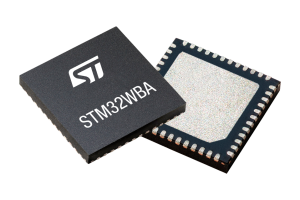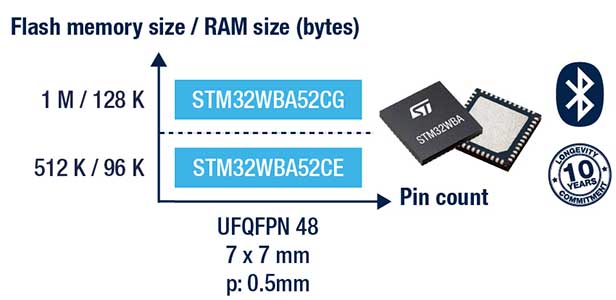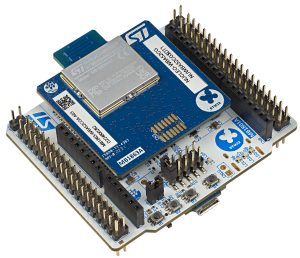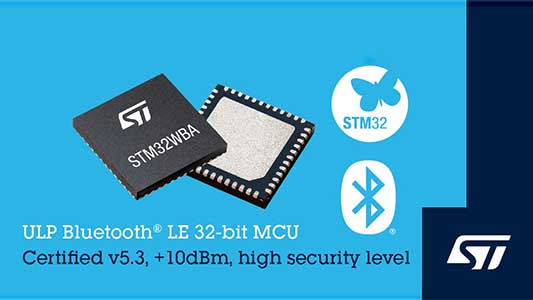The STM32WBA52xx are now available in a QFN32 package measuring only 5 mm x 5 mm as opposed to the QFN48 package of 7 mm x 7 mm. Integrators will gravitate towards the models with fewer pins for projects that use fewer interfaces and timers, which are often used for wake-up capabilities, among other things. While the first STM32WBA maximized features, we also know that not all developers need 16 wake-up pins and would rather get the benefits of a smaller package. The QFN32 housing can thus help them tailor their systems to save space to create a more compact and cost-effective design.
Original publication, March 10, 2023
The STM32WBA is the first wireless STM32 to open the way for a Bluetooth Low Energy 5.3 and SESIP Level 3 certification. At its heart, the new series uses an architecture inspired by the STM32U5. We find a similar Cortex-M33, but running at 100 MHz, and flash capacities varying from 512 KB to 1 MB. While the STM32WBA has a dedicated firmware package (STM32CubeWBA), it supports current profiles for STM32WB microcontrollers, thus vastly facilitating the transition from the STM32WB to the STM32WBA. ST also improved the radio to reach +10 dBm in output power, making it the first wireless MCU of its kind to provide such a robust link.
A new architectural foundation
A Cortex-M33

The STM32WBA52xx are now available in a QFN32 package measuring only 5 mm x 5 mm as opposed to the QFN48 package of 7 mm x 7 mm. Integrators will gravitate towards the models with fewer pins for projects that use fewer interfaces and timers, which are often used for wake-up capabilities, among other things. While the first STM32WBA maximized features, we also know that not all developers need 16 wake-up pins and would rather get the benefits of a smaller package. The QFN32 housing can thus help them tailor their systems to save space to create a more compact and cost-effective design.
Original publication, March 10, 2023
The STM32WBA is the first wireless STM32 to open the way for a Bluetooth Low Energy 5.3 and SESIP Level 3 certification. At its heart, the new series uses an architecture inspired by the STM32U5. We find a similar Cortex-M33, but running at 100 MHz, and flash capacities varying from 512 KB to 1 MB. While the STM32WBA has a dedicated firmware package (STM32CubeWBA), it supports current profiles for STM32WB microcontrollers, thus vastly facilitating the transition from the STM32WB to the STM32WBA. ST also improved the radio to reach +10 dBm in output power, making it the first wireless MCU of its kind to provide such a robust link.
A new architectural foundation
A Cortex-M33
The STM32WBA represents a new approach to our wireless MCUs. The original STM32WB had a Cortex-M0+ running the radio stack and a Cortex-M4 for the application. The STM32WBA uses a single Cortex-M33 with a score of 407 in CoreMark, which is twice the performance of the previous generation. Beyond computational improvements, the new architecture simplifies developments and provides new features. For instance, the STM32WBA offers an interface for touch sensors that could serve industrial applications and one advanced timer for motor control.
Similarly, the new device supports a background autonomous mode (BAM). It enables peripherals to remain functional and use direct memory access (DMA) without waking the CPU. Engineers can perform sensor monitoring operations using BAM through I2C, SPI, or UART, increasing the usefulness while keeping the power consumption low. Additionally, the STM32WBA supports low-power STOP0, STOP1, and standby modes that developers find in the STM32U5, but ST tweaked them to go rapidly from a running mode with connectivity to Standby mode with the radio context written in the memory. Standby mode with RTC only needs 200 nA, and the Stop mode with 64 KB of RAM demands 16.3 µA.

A more robust signal
The radio also received significant optimizations as it’s the first in this kind of product to reach +10 dBm in output power, thus offering a more robust wireless link. The new performance can make a significant difference when connecting to a device despite an obstruction diminishing the signal. The STM32WBA also supports important features like long-range transmissions, a high-speed connection of up to 2 Mbps, and advertising extensions to optimize communication management. Moreover, while the STM32WBA52 relies on LDOs, future models in the series will also feature a switched-mode power supply. Similarly, while the STM32WBA52 only focuses on, future devices will support Matter, OpenThread, and Zigbee.
A new security paradigm
The presence of a Cortex-M33 in STM32WBA devices also means that, for the first time, our wireless microcontrollers can help provide a SESIP Level 3 certification. Developers can use functionalities like TrustZone, Trusted Firmware, Secure Boot, Secure Debug, and more to bolster their security and protect sensitive applications from the radio stack. Thanks to ST software packages and firmware, developers can more easily implement privileged and unprivileged sections to safeguard sensitive information like cloud credentials or user data.
Existing solutions within the STM32Trust initiative will help users implement these safeguards. Furthermore, because the STM32WBA takes cues from the STM32U5, developers can reuse some of the information or documentation. Nevertheless, ST will have specific content on the STM32 Wiki to address issues related to wireless stacks. The new devices will also include mechanisms protecting against physical attacks, such as anti-tamper pins, a unique hardware key, and more.
Getting started

The best way to start creating a proof-of-concept is to grab the new NUCLEO-WBA52CG, a new type of Nucleo board where the microcontroller sits on a removable daughter card. The solution can help engineers more easily swap between microcontrollers, making the device more portable. By using the board, developers could determine whether their application can use ST’s basic Bluetooth stack, which helps save memory, or if they require the full-featured version. ST will also provide bare metal middleware and firmware using AzureRTOS. A software package using FreeRTOS will also be available on GitHub Hotspot, which already contains a repository for a web interface supporting the new device.












